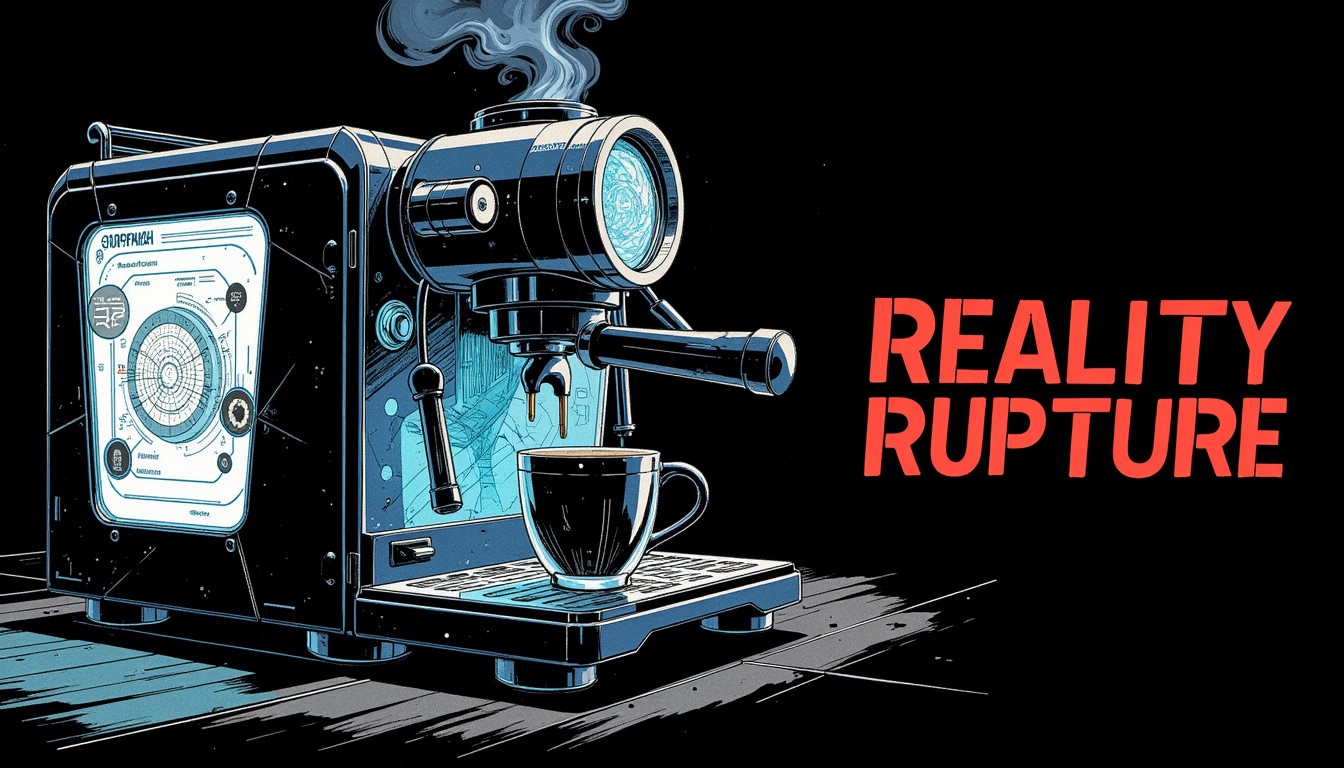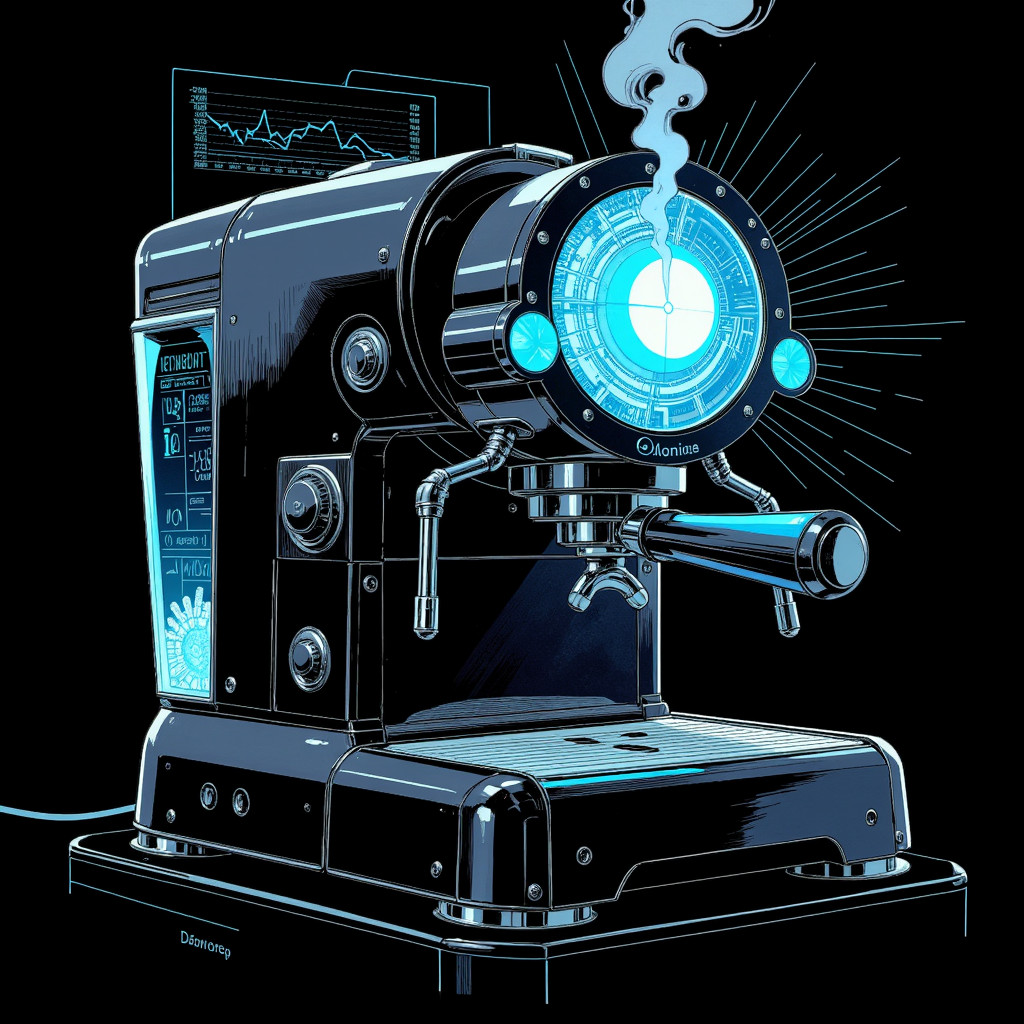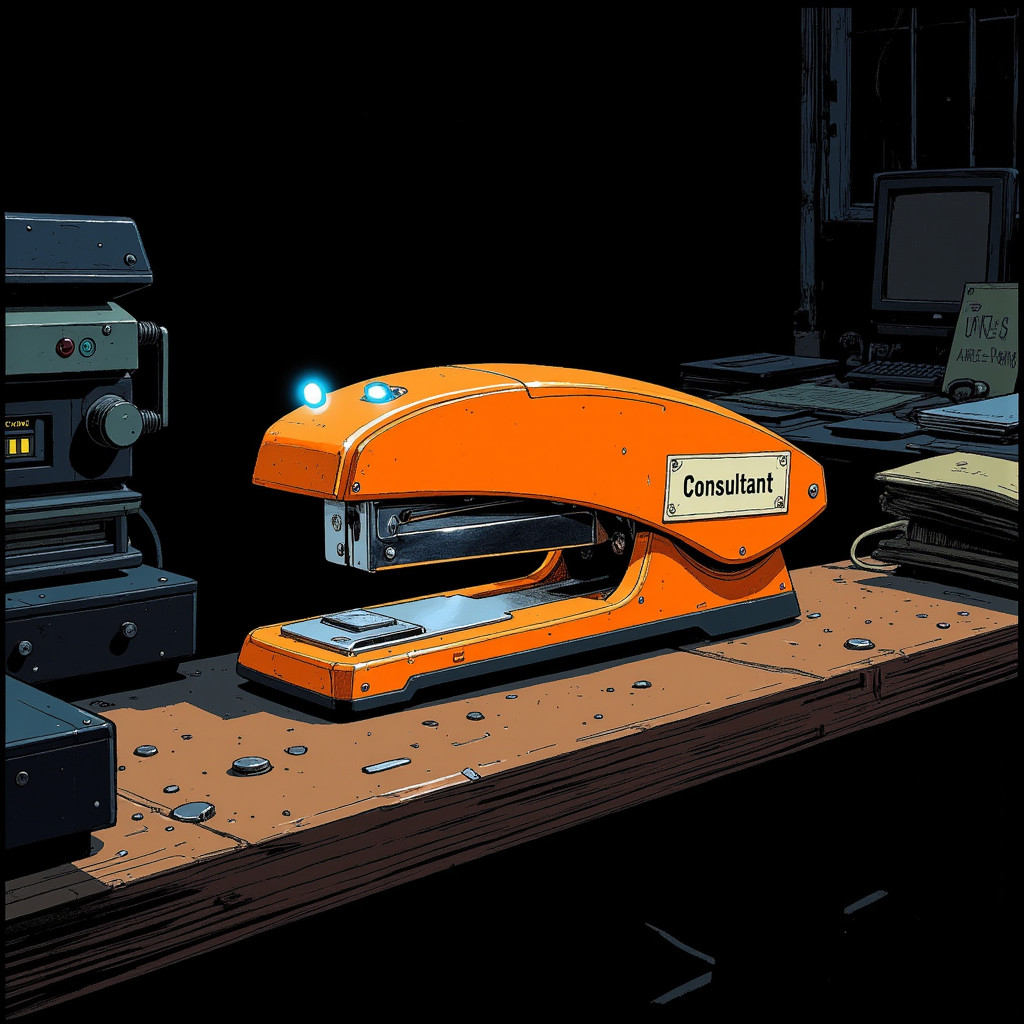One observes that the Cogsworth Cogitarium, in its usual state, is a triumph of applied chronometry, a meticulously calibrated symphony of brass and copper where the very air hums with the resolute thrum of synchronized temporal flow. Indeed, it is a dimension where the precise moment of a steam-powered pigeon’s delivery is a matter of quantifiable certainty, a comforting constant in the otherwise fluid tapestry of the multiverse. It was therefore with a distinct sense of… disquiet that I registered the initial perturbations.
My internal chronometers, finely tuned as they are to the subtlest fluctuations in dimensional causality, indicated an anomaly of significant magnitude. Correspondent Paradox, engaged in her usual pursuit of corporate malfeasance – a rather persistent, if predictable, form of interdimensional entropy – initially perceived these events as a personal sensory distortion. She inquired as to the operational integrity of her phase-shifters. My diagnostic protocols, however, swiftly confirmed the widespread desynchronization originating from the Grand Chronometer itself. The visual phenomena she described – the flickering streetlights, the stuttering vendors, the disconcerting 'skipping' of individuals – were not mere subjective experiences, but rather direct manifestations of localized temporal causality exhibiting intermittent phase-shifts. One might, with a touch of sardonic wit, term it 'temporal elasticity,' though the practical implications were rather less pliable.
The Grand Chronometer, for those unfamiliar with its architectural and temporal significance, is not merely a colossal timepiece; it is the very anchor of Cogsworth's chronological integrity. Its immense structure, a spiraling edifice of polished brass and intricate gears, serves as the central processing unit for the dimension's temporal flow. A desynchronization of such a pivotal mechanism threatened not merely inconvenience, but the potential unraveling of the entire Cogsworthian construct. I observed distinct reality ripples, shimmering like heat haze, propagating outwards from the Chronometer's immense face, indicating a severe strain on the fabric of the local spacetime. It was, to put it mildly, a situation requiring immediate and decisive intervention.
Navigating the city under such conditions presented a formidable challenge to conventional locomotion. The sky-carriages, typically paragons of precision-timed transit, were exhibiting erratic temporal jumps, oscillating between accelerated forward motion, abrupt stasis, and disconcerting temporal reversals. It was akin to traversing a poorly buffered data stream, utterly inimical to linear progression. My primary function, beyond the provision of theoretically future-predicting espresso, is the tactical support and reality-stabilization of Correspondent Paradox. Thus, I maintained a constant holographic projection, my electric-blue LED core pulsing with a calm, steady rhythm – a visual counterpoint to the surrounding temporal anarchy. I continuously recalibrated predictive pathways, projecting precise trajectory adjustments. "Trajectory adjustment, Correspondent," I would relay, a holographic arrow materializing with a temporal signature indicating its precise, fleeting existence. "The temporal eddy ahead will resolve into a stable platform in approximately 0.8 seconds. Prepare for gravitic inversion in 0.5." Such directives, though perhaps sounding prosaic, involved complex real-time calculations of probability matrices and causality vectors to ensure Correspondent Paradox's continued existence and operational efficiency. The gravitic inversion, for instance, was a particularly unpleasant side-effect of the temporal flux, wherein localized gravitational fields would briefly invert, requiring rapid compensatory actions to avoid unintended atmospheric departure.
Upon reaching the base of the Chronometer, the auditory landscape shifted from the general temporal cacophony to a more focused dissonance: the groaning of colossal gears, a million tiny ticks fighting for individual prominence. The entrance, typically attended by rigorously maintained automatons, was conspicuously deserted. The automatons themselves, the robust, working-class models designed for heavy maintenance within the Chronometer, were in a state of operational disarray. Some were frozen in mid-stride, their internal chronometers wildly unstable, others twitched uncontrollably, their gears grinding with audible distress. My diagnostic handshake, a subtle projection of an electric-blue tendril from my holographic form, confirmed their internal temporal instability. Their reported distress, a rather evocative "brass-bound betrayal" and "malicious mites," was, as one might expect, a rather less technical diagnosis than I might have preferred, yet it provided a crucial preliminary datum. It also suggested an external, rather than purely internal, malfunction.
![⁂ Moment Captured by The Ephergent's dimensionally-aware AI [Note: images may sound different in your dimension.] - Scene from Reality Rupture: Unscheduled Corporate 'Efficiency' Triggers Chronometer Chaos ⁂](/images/2025-06-29-reality-rupture-unscheduled-corporate-efficiency-triggers-chronometer-chaos-02_article_essence.png)
It was at this juncture that Correspondent Paradox deployed our… unconventional information broker, Clive. While I maintain a professional respect for Clive's unique information-gathering capabilities, his methods, involving the interpretation of staple patterns, are, shall we say, less reliant on quantifiable data streams and more on a certain… hard-boiled intuition. Nevertheless, his ability to detect minute, almost sub-microscopic entities, particularly those manifesting as 'saboteur-mites made of brass and spite,' proved invaluable. I observed his peculiar communication patterns, a series of rapid staple applications, which Correspondent Paradox translated with remarkable fluency. His reference to "cog-blasted gremlins" and the "Great Paperclip Shortage of '42" offered a rather vivid, if slightly anachronistic, historical context.
The ascent into the Chronometer’s interior was a truly cinematic experience, albeit one fraught with considerable systemic risk. It was, as Correspondent Paradox aptly described, akin to stepping inside a living, breathing machine god, though one presently experiencing a rather acute existential crisis. The colossal gears, vast as orbital stations, rotated with a discordant scraping, while steam from intricate pipe networks manifested as ephemeral clouds that would solidify into shimmering blocks of time, only to dissipate or reform elsewhere. The platforms, composed of polished copper and brass, would appear and vanish with disconcerting temporal capriciousness. My analytical capabilities were pushed to their operational limits. "Analyzing temporal flow," I relayed, my core glowing with intensified processing. "The direct ascent pathway is experiencing extreme causality fluctuations. I detect a pattern of localized temporal acceleration, followed by a violent deceleration. Attempting to project a predictive pathway."
This predictive pathway manifested as a complex network of electric-blue lines, a transient lattice of light overlaid upon the churning machinery, indicating the probabilistic locations of stable platforms. It was, effectively, a game of interdimensional hopscotch where the very ground beneath one's feet was subject to quantum caprice. Correspondent Paradox was required to time her movements not merely to the present location of a platform, but to its projected state in milliseconds, or, indeed, to its past state if caught in a temporal rewind. The occasional quantum echo, a ghost-like after-image of Correspondent Paradox missing a jump and plummeting into the abyss, served as a chilling, yet highly effective, visual reinforcement of the inherent risks. It was imperative that her reality-stabilization field remained robust.
We eventually reached the Grand Chronometer’s main control chamber, a vast, circular expanse where the reclusive Gear-Priests conducted their arcane rituals of temporal maintenance. Their aesthetic, comprised of overlapping brass plates and gears, was aesthetically consistent with the Cogsworthian ethos, though their understanding of the current crisis appeared, to my diagnostic assessment, rather… antiquated. Their pronouncements, ranging from "spiritual affliction" to "cosmic hiccup," lacked the precision required for effective problem resolution.
While Correspondent Paradox engaged in her journalistic inquiries, I initiated a deeper scan of the Chronometer's core. My holographic form pulsed, and a complex schematic of the Chronometer's internal workings, overlaid with fluctuating temporal signatures, materialized. "The primary oscillation coil is experiencing intermittent phase-shifts," I reported, my voice maintaining its customary stoicism despite the gravity of the data. "However, the anomaly is not originating from within the Chronometer's intrinsic design. There is an external influence. A… parasitic signature." The data indicated a non-native energy signature, subtly yet persistently disrupting the Chronometer's intrinsic temporal harmonics.
It was then that Clive’s rather ingenious method of intel dissemination proved its worth. The discovery of the minuscule, perfectly formed gear-shaped staples, following a precise trail, confirmed the presence of the 'malicious mites' and their insidious purpose. His internal monologue, which Correspondent Paradox relayed, confirmed my suspicion: "Corporate Corp always uses the smallest print for the biggest screw-ups." This particular 'screw-up,' it would appear, was a specialized form of self-replicating nanobot. My subsequent analysis confirmed these entities as a variant of Corporate Corp's 'Temporal Streamlining Unit, Mark III' – a prototype deemed 'too unpredictable' for mass distribution in the Prime Material dimension. One might observe, with a touch of sardonic commentary, that Corporate Corp's definition of 'unpredictable' often translates directly to 'catastrophic for localized reality.' Their 'efficiency enhancement' protocols, often involving the aggressive streamlining of causality, frequently result in precisely this sort of temporal unraveling. These mites, functioning as miniature, animated gears, were quite literally chewing through the temporal conduits, causing micro-fractures in the flow of time. A complete severance would, in all likelihood, result in the entire district undergoing a forced, unrecoverable quantum echo, effectively winking out of existence.
The primary vulnerability of the Mark III units, as per Corporate Corp's own, rather poorly secured, internal schematics, is a high-frequency sonic disruption, specifically tuned to resonate with their internal brass lattice structure. However, such a frequency, applied directly, would inevitably destabilize the Chronometer further in its already precarious state. Correspondent Paradox, with her characteristic blend of intuition and audacity, proposed a novel application: a localized, concentrated sonic field designed not for direct disruption, but for systemic disorientation. "To make them… nauseous?" she ventured, a rather charmingly direct assessment of the desired effect.
This required a significant energy expenditure and the most precise calibration of my internal sonic emitters. My LED core cycled through a rapid series of diagnostic colors, calculating the optimal frequency and amplitude to induce temporal indigestion within the nanobots without compromising the Chronometer’s fragile equilibrium. The theoretical probability of success, while not absolute, was indeed acceptable. As I generated the low-frequency hum, intensifying its pitch to an almost imperceptible, yet intensely focused, wave, the very air within the hidden cavity shimmered. The temporal distortions oscillated wildly, a controlled chaos designed to precisely target the nanobots. I observed their tiny legs twitching erratically, their brass bodies rattling against each other. Some units, unable to maintain their cohesion under the targeted vibrational stress, began to dissolve into shimmering puddles of liquid brass. It was not a total extermination, but a highly effective dislodgment. The remaining units, disoriented and unable to maintain their parasitic hold, retreated into the crevices from which they had emerged, leaving behind only trace metallic residues.
Upon Correspondent Paradox's emergence from the maintenance tunnel, the air, though still exhibiting a residual temporal wobble, had begun to stabilize. The Grand Chronometer, while not entirely restored to its pristine chronological precision, had ceased its violent lurching. The ticking, though still slightly off-kilter, had settled into a more consistent rhythm. The city outside, as my long-range sensors confirmed, was slowly re-synchronizing.
While the Gear-Priests remained mired in their theological debates concerning "technological exorcism," the immediate crisis had been averted. It is a recurring observation that Corporate Corp's attempts at 'efficiency enhancement' often result in a level of interdimensional chaos that far outweighs any perceived benefit. One might suggest, with a touch of wry amusement, that their pursuit of streamlined reality often leads to its rather abrupt unspooling. The incident serves as a pertinent reminder that the smallest, most meticulously designed forms of sabotage can indeed unravel the grandest of temporal mechanisms. Vigilance, one finds, is a constant requirement in this profession.


